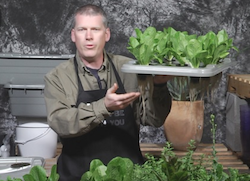 A Texas patent holder and inventor has launched a collection of 3D printable objects that function as key components in a non-electric, home-based food grow system that can be operated for pennies. The story of the invention can be found at FoodRising, a project of the non-profit Consumer Wellness Center which is donating 250 grow systems to schools across America.
A Texas patent holder and inventor has launched a collection of 3D printable objects that function as key components in a non-electric, home-based food grow system that can be operated for pennies. The story of the invention can be found at FoodRising, a project of the non-profit Consumer Wellness Center which is donating 250 grow systems to schools across America.
The Food Rising Mini-Farm Grow Box grows enormous quantities of food without using electricity or soil. It requires no weeding and uses no pumps, motors or complex parts of any kind. It grows highly-nutritious, mineral-rich foods using about 1/20 the water of conventional agriculture and about half the space of soil gardening.
Mike Adams, also known as the “Health Ranger,” developed the system based on the work of Professor Kratky and gives away the 3D printable parts via downloadable files at FoodRising. Adams is also distributing DIY videos that instruct people on how to build their own systems using inexpensive parts and common tools. Pre-built systems are offered for sale at Supply Source.
“The Maker movement is about empowering people with innovative, grassroots solutions that can substantially improve the quality of their lives,” Adams explains. “This Food Rising Mini-Farm Grow System allows people to produce their own mineral-rich, better-than-organic foods for mere pennies.”
Mike Adams is a science lab director and food activist who tested numerous grow technologies (such as hydroponics and aquaponics) before developing the Food Rising Mini-Farm Grow Box. It’s based on a concept taught by Univ. of Hawaii professor B. Kratky, and it’s called a “constant bottom feeding non-circulation hydroponics” system.
The system requires an automatic self-watering float valve to function correctly, so Adams designed a 3D printable float valve that uses readily available parts to function: A pencil eraser, a paper clip, a garden hose washer and a discarded vitamin bottle. The 3D printed parts can be printed from filament that’s made partially out of recycled plastic landfill trash, allowing people to “transform trash into food production systems,” explains Adams.

